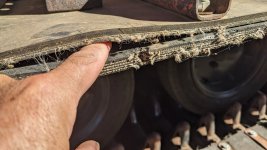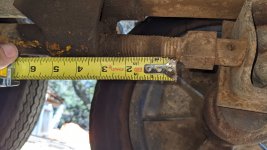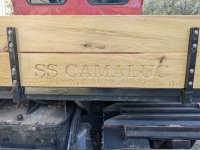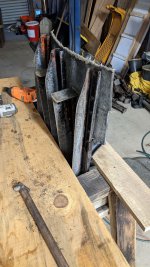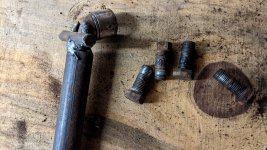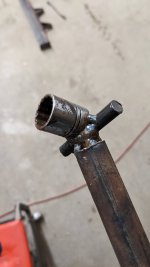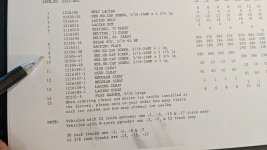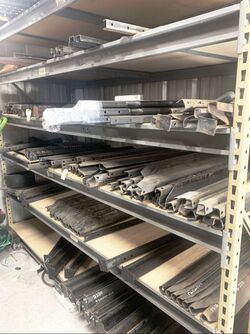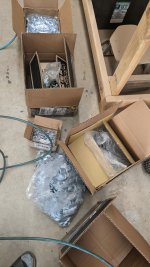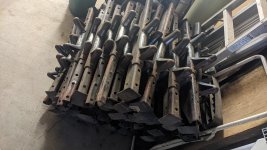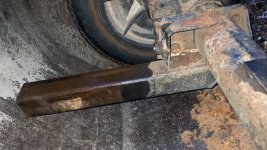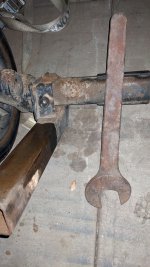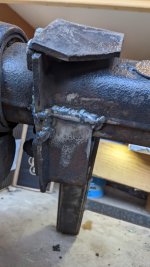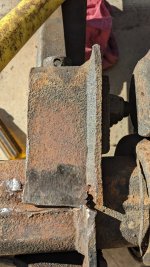I am trying to order new belts from fall line in Reno. I have spoken with the rep there about getting the replacement belts. side note: ouch! Expensive, but from what I can gather, they are good quality belts.
MY problem is this: The track system is cobbled together. On one side of the cat, the inside two belts are (appear to be) original belts. Both five inches wide with the 8" pitch and four inch pitch. On the two outside belts they have a 10" belt with the two five inch belts mated to each other.
Factory calls for 72 grousers, I got 73.
There are no lacings being used, just overlapped. Actually there are many breaks in the belts which have been mended.
SO... Fall Line can not suggest how to go about measuring for the replacement belts, I even offered to take the machine up there and have them do the take off as I do not want to give wrong info and be on the hook for the $. I think because the belts have been modified, they are concerned what else may be changed which would throw off the measurements(?).
My current thought is to just cut one track off, remove one grouser and re-attach. If I can reinstall the belt, then, in my mind, I can revert back to the original 72 grouser count. If you look at the pictures of the track belt adjustment screws, It looks like I have about two inches remaining inside the sleeve for additional adjustment out OR about five inches shorter. With so little thread contact, I feel it is weak, shortenings the track (if it will fit) should give me a stronger mount.
What are the thought on how I should proceed? I need to figure out how to measure for the belt replacement, but with it being in the state that it is, I am at a loss.
(I plan on using laces)
As always,
Thanks for any and all help
rockaukum
1971 1202B Thiokol
Pic one shows just a tire guide, missing grouser?
Pic two shows how they mated the five inch belts with the ten inch belt on the outsides only
Pic three shows the two belts mated
Pic four and five show the track adjustment screws
Pic six shows the inside belts, looks like original five inch belts there
MY problem is this: The track system is cobbled together. On one side of the cat, the inside two belts are (appear to be) original belts. Both five inches wide with the 8" pitch and four inch pitch. On the two outside belts they have a 10" belt with the two five inch belts mated to each other.
Factory calls for 72 grousers, I got 73.
There are no lacings being used, just overlapped. Actually there are many breaks in the belts which have been mended.
SO... Fall Line can not suggest how to go about measuring for the replacement belts, I even offered to take the machine up there and have them do the take off as I do not want to give wrong info and be on the hook for the $. I think because the belts have been modified, they are concerned what else may be changed which would throw off the measurements(?).
My current thought is to just cut one track off, remove one grouser and re-attach. If I can reinstall the belt, then, in my mind, I can revert back to the original 72 grouser count. If you look at the pictures of the track belt adjustment screws, It looks like I have about two inches remaining inside the sleeve for additional adjustment out OR about five inches shorter. With so little thread contact, I feel it is weak, shortenings the track (if it will fit) should give me a stronger mount.
What are the thought on how I should proceed? I need to figure out how to measure for the belt replacement, but with it being in the state that it is, I am at a loss.
(I plan on using laces)
As always,
Thanks for any and all help
rockaukum
1971 1202B Thiokol
Pic one shows just a tire guide, missing grouser?
Pic two shows how they mated the five inch belts with the ten inch belt on the outsides only
Pic three shows the two belts mated
Pic four and five show the track adjustment screws
Pic six shows the inside belts, looks like original five inch belts there


